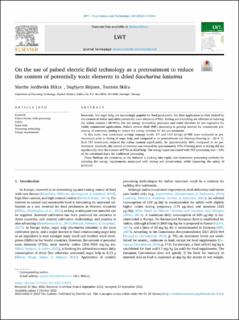| dc.contributor.author | Blikra, Marthe Jordbrekk | |
| dc.contributor.author | Skipnes, Dagbjørn | |
| dc.contributor.author | Skåra, Torstein | |
| dc.date.accessioned | 2022-11-28T10:01:45Z | |
| dc.date.available | 2022-11-28T10:01:45Z | |
| dc.date.created | 2022-10-24T10:50:51Z | |
| dc.date.issued | 2022 | |
| dc.identifier.citation | Lebensmittel-Wissenschaft + Technologie. 2022, 169 . | |
| dc.identifier.issn | 0023-6438 | |
| dc.identifier.uri | https://hdl.handle.net/11250/3034398 | |
| dc.description.abstract | Seaweeds, like sugar kelp, are increasingly popular for food production, but their application is often limited by the content of iodine and other potentially toxic elements (PTEs). Boiling and blanching are efficient in reducing the iodine content (-38-94%), but are energy demanding processes and could therefore be too expensive for viable commercial applications. Pulsed electric field (PEF) processing is gaining interest for commercial processing of seaweeds, aiming to reduce the energy demand for the pre-treatment. In this work, two conditional settings (energy levels: 2.7 and 14.4 kJ/kg) of PEF were evaluated as pretreatments prior to drying of sugar kelp, and compared to no pretreatment and freezing/thawing at −20/4 °C. Both PEF treatments reduced the iodine content significantly, by approximately 40%, compared to no pretreatment. Similarly, the content of mercury was reduced by approximately 19%. Freezing prior to drying did not significantly alter the content of PTEs in dried kelp. The energy input associated with PEF processing was <10% of the calculated input for traditional processing. These findings are promising as the industry is looking into rapid, non-destructive processing methods for reducing the energy requirements associated with drying and preservation, while improving the safety of products. | |
| dc.language.iso | eng | |
| dc.title | On the use of pulsed electric field technology as a pretreatment to reduce the content of potentially toxic elements in dried Saccharina latissima | |
| dc.title.alternative | On the use of pulsed electric field technology as a pretreatment to reduce the content of potentially toxic elements in dried Saccharina latissima | |
| dc.type | Peer reviewed | |
| dc.type | Journal article | |
| dc.description.version | publishedVersion | |
| dc.source.pagenumber | 0 | |
| dc.source.volume | 169 | |
| dc.source.journal | Lebensmittel-Wissenschaft + Technologie | |
| dc.identifier.doi | 10.1016/j.lwt.2022.114033 | |
| dc.identifier.cristin | 2064263 | |
| dc.relation.project | Norges forskningsråd: 2549963 | |
| cristin.ispublished | true | |
| cristin.fulltext | original | |
| cristin.qualitycode | 1 | |
